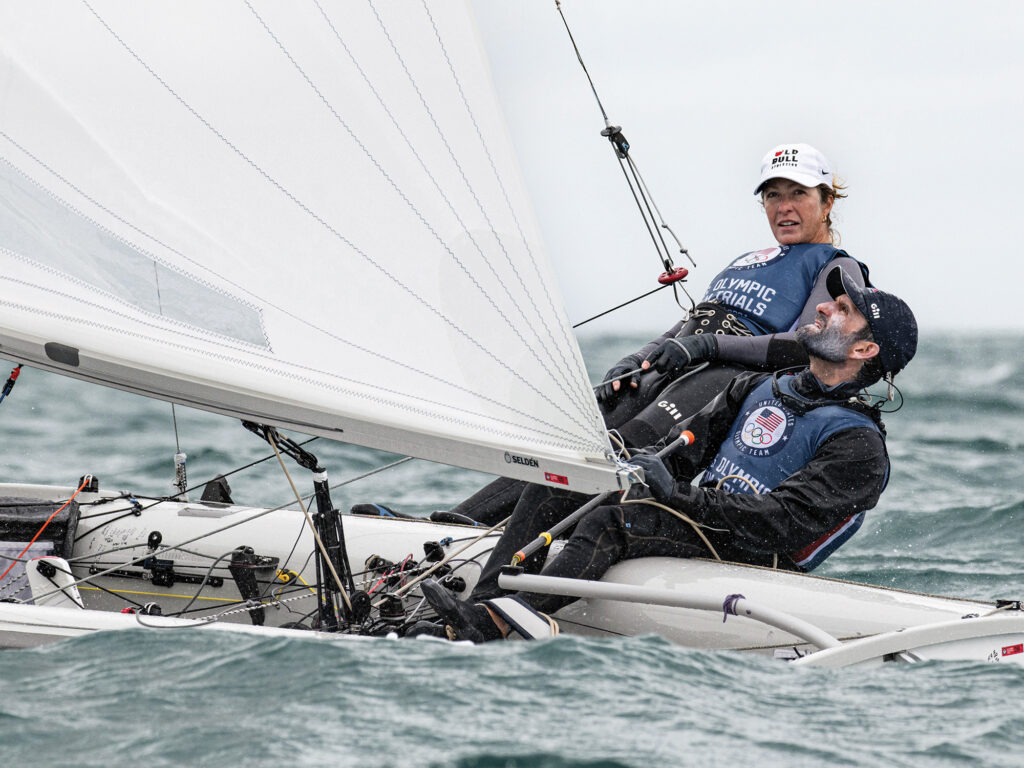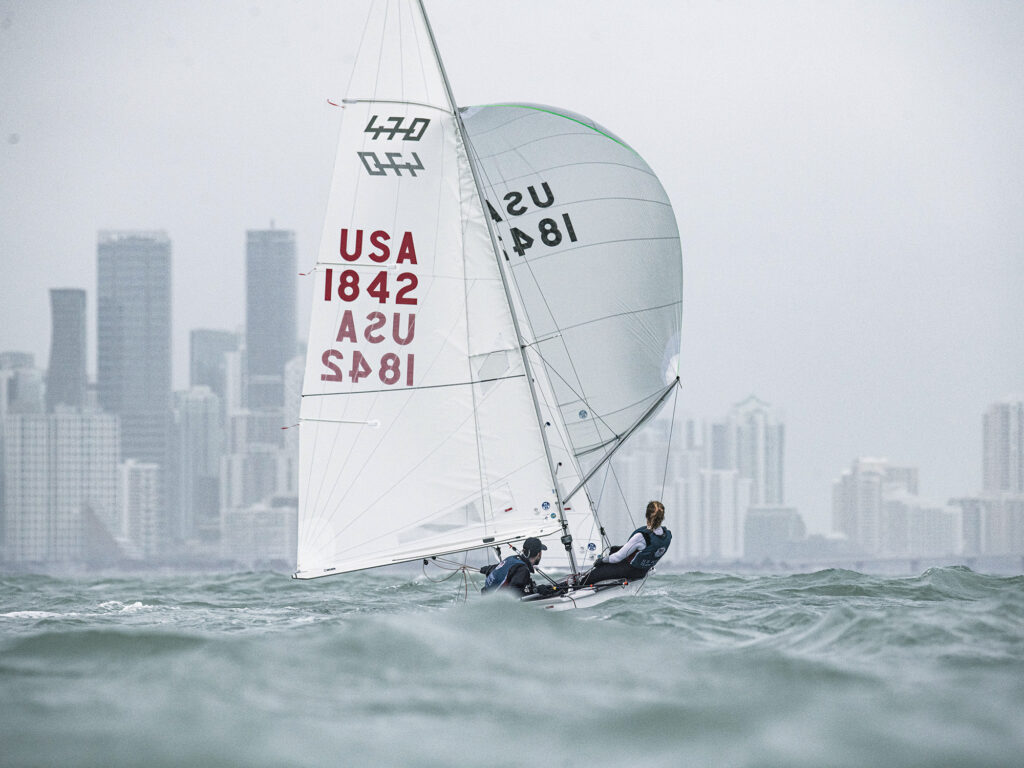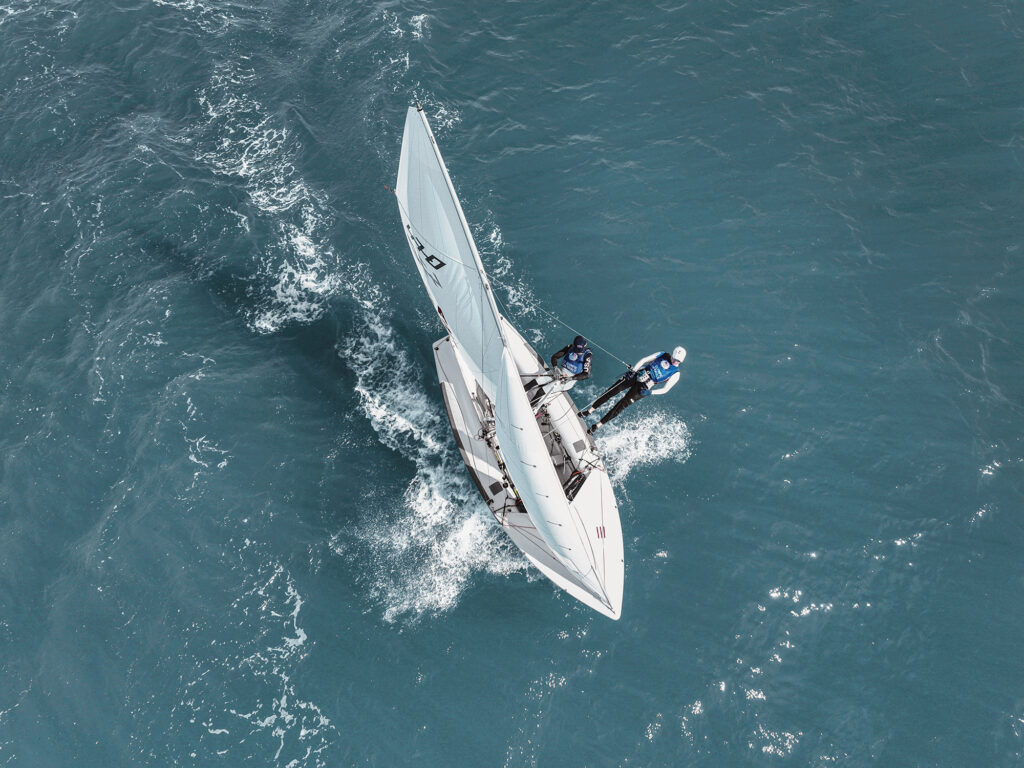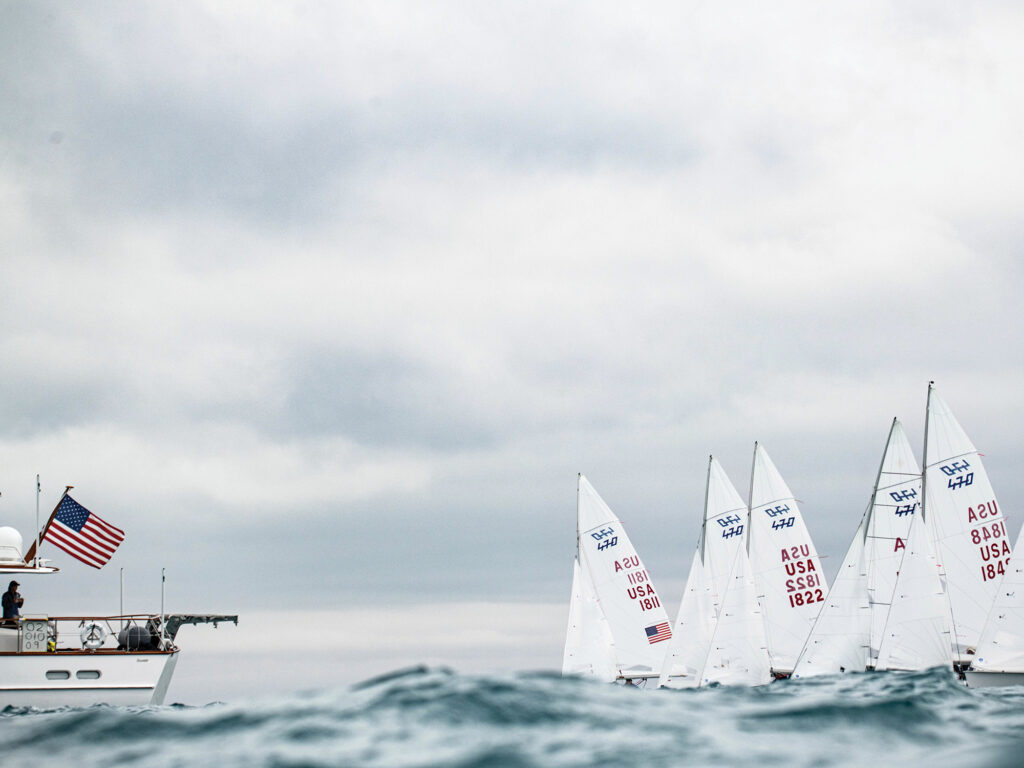
After a week of blustery cold-front tails whipping through Miami, this final morning is back to normal. The basin is glassy and the sun is balmy again. As my skipper, Stu McNay, and I rig our International 470, a nearby cruise ship’s PA system breaks the boat-park silence. Welcome passengers…enjoy your day at sea. I think to myself how different their day will be than that of Stu and me. The cruisers are salivating for their buffets, but we’re hungry for an Olympic berth.
Once we complete our team warmup onshore, we are the first pair to launch from the beach, primed to execute. Over the previous six days of racing, we’ve enjoyed the sightseeing tour of our 30-minute tow to the racecourse, past multimillion-dollar mansions and through Government Cut. We use this time to acclimate to the day’s conditions. Right away, we see that the wind is increasing and beautiful waves are cresting over the shallows off South Beach. When I see this, I sense that it’s going to be a good day.
Our priority is to stay in the moment and allow our technique to shine. We’ve put in the work, and it’s payday. The anticipated scenario is a must-go-right racetrack off the starting line, so today is about being a precision team. We also know that we have to practice our final approach to the starting line because the committee boat is a long motoryacht with the start flag positioned at the bow. The race-committee yacht also swings wildly, which makes boat-end starts even more dangerous. So we agree to a modified approach. We will approach the boat at 20 seconds. Any sooner, and it will be difficult to tack up to the boat and defend the inside position.
We execute the start as planned, but at 30 seconds, there is a pile of boats with the same idea, and there’s nowhere to go. We wait confidently, pull the trigger at 20 seconds, and are the first boat to tack out from the melee.
As we reach the top mark, we have a small lead. In races like this, all of my senses are firing, and I tune in to friends on our support boat cheering for us. It’s the motivation we need to finish off this qualification regatta once and for all. There isn’t a moment of silence in our boat for the next 35 minutes of racing. We treat every wave as important as the next while keeping each other in check. Our tacks are excellent, and before each maneuver I think to myself, Make this one the best one yet. It’s working. We extend downwind, port jibe is fast and fun on the waves. Starboard requires accuracy and discipline to surf. This final race is a thing of beauty. We are worthy of the berth.
Allow me to rewind this story to a moment now long ago. I’ve finished the last race at the Tokyo 2020 Olympics, and immediately after we cross the line, out of medal contention, I know that I need another campaign. I have unfinished business, which is not a good feeling. My skipper, Nikki Barnes, and I have had a beautiful campaign together, but because the Olympic committee changed the International 470 to a mixed discipline, we can no longer sail as a team. I need a new partner.

Back home in Minnesota, I ask anyone and everyone in my circles to skipper for me. My body type is one that can work into several Olympic classes, but the most important aspect is my teammate. I commit to a yearlong campaign in the foiling Nacra 17, the Olympic catamaran class, and during this time, Stu, a four-time Olympian, calls me to say, “Hey, Lara, I am 99 percent sure I’m going to retire, but if things don’t work out in the Nacra, keep me in the back of your mind.”
But I feel that I need to grow in other ways and leave the 470 on the back burner. I’m happy being back in the beginner’s mindset and loving anything to do with foiling. I also have my eye on the Women’s America’s Cup team that’s forming. A path forward is coming into focus, but after the 2022 Nacra 17 Worlds, my teammate joins the New York YC’s American Magic team full time. Once again, I’m in the same space I was in after Tokyo—searching for a teammate and a campaign to light my fire. My best friend suggests that I give Stu a call and reopen the conversation. It’s a short and exciting phone call, and we both show strong interest. Over the next month, I sit by my phone waiting.
The phone rings. Stu’s in. It’s a go.
I remember two things about our first sail together: He is incredibly stubborn about not letting the main ease when I have more leverage to give, and he can tune our boat in five minutes. My mind is blown, and I am so excited to tap his wealth of experience.

We win our first two domestic regattas and earn the right to represent the US at the Olympic Test Event in Marseille in summer 2023. We then finish eighth at the Princess Sofia Regatta, our first international measure. The campaign is off to a great start, but when we arrive at the European Championship and are met with giant ocean swells and a big breeze, we quickly discover our weakness.
Beyond learning a new way of sailing the boat (our bodies and techniques are very different from each of our previous partners), we will need to order and test entirely new equipment from what either of us has used before. Discovering weaknesses is always a fun challenge; it’s part of the life we lead. This part I can handle, but what’s dragging me down is our fundraising—or lack thereof. It’s an area in which I usually excel, but I’m now sinking into the deepest debt I’ve ever had. Donations are hard to come by. Then, right before our first world championship, I receive the most powerful blow to my world: My dad has lymphoma, and together my parents are about to fight this awful disease. I approach this news the way I do any major obstacle in our training. I dive into the research to learn what I can. I keep a positive mindset. My parents are my biggest heroes, and thinking of Dad and what he is about to attack doesn’t allow for me to have a single complaint on or off the water.
I have to avoid the family for the holidays to keep foreign germs to myself and focus on the task at hand. This is gutting because I want nothing but to hug my parents, to sit with Dad, and physically be there to support him. In these moments of hurt, however, we grow and become the greatest versions of ourselves.
It is mid-October 2023 when I start to mentally prepare for the trials, set aside the variables I can’t control, and focus on being my best athlete. If we are going to win, it will take all I have. I accept my debt, so it isn’t a nagging worry. I immerse myself in books and documentaries about athletes conquering their dreams and work closely with my mental coach. I also add boxing to my routine, and I love the quickness it gives me, the explosive power, and memorizing steps.
Stu and I then make the most important decision of our campaign: to relocate to the Canary Islands to train with the international fleet. To achieve anything great, we will have to struggle together, and the regular racing season doesn’t allow for much growth in this way. What really makes this happen is being in an environment where our competitors hold us to our highest standards every day. The days are long, there are no regatta distractions, and we say whatever is on our mind. This is what will give us solid ground to stand on in the heat of battle and a shared ownership of our accomplishments.
During our first training block in Lanzarote, things on the boat are becoming familiar as a team. Stu and I are creating our language on board. We have now experienced a variety of sea states and dialed in a few specific terms that connect us to certain techniques. This is where the fun happens because our days are spent seeking small performance gains. Our Lanzarote training gives us the gift of preparation and chemistry. Stu is humble, he always wants to learn and grow, and he’s a supportive teammate. There is nothing more I can ask for. He has such a natural feel for a perfectly balanced 470, and his range of controls is very narrow, quick and accurate. He is a legend for good reason.

It’s the eve of our final day of racing at the trials in Miami. Our team gathers for dinner, and Coach Robby Bisi delivers an inspiring speech. The kind of speech that puts a team on track for winning the next race. And that we do, with confidence. After we cross the finish line, my mind is still racing. It’s impossible to grasp the magnitude of what has happened. The mix of emotion and exhaustion is such a wild experience. There is a sense of accomplishment with the race that we’ve sailed and won, but it brings uncertainty because nothing in our sport is final until the protest time limit is over. I recognize that this is not just our win; it’s a milestone to share with our friends and family who take this emotional ride with us and our competitors and squad mates who put their hearts on the line alongside us.
On our tow back to Miami YC, I ask Stu to share his high and low of the day. “My high was taking the main down,” he says. He’s kidding, of course, but it’s true. This regatta has taken its toll on all of us. It is the hardest thing I’ve ever done in my life, mentally and physically. It’s been a long road to get here, from watching peers compete at the 2012 and 2016 Games and wanting so badly for the chance to be in their shoes to being told that I will never have the looks or talent to make it in the sailing world—but this gal is now 2-for-2 on the trials card.









